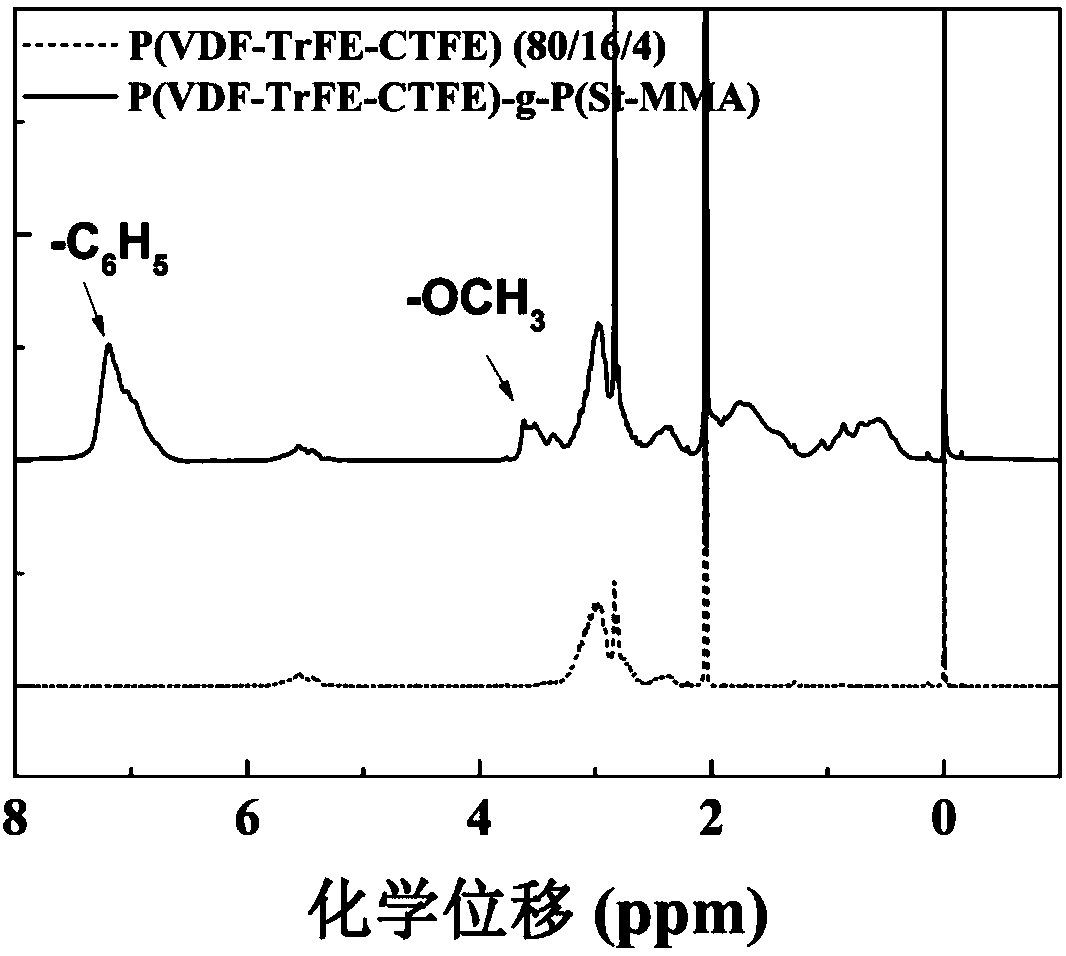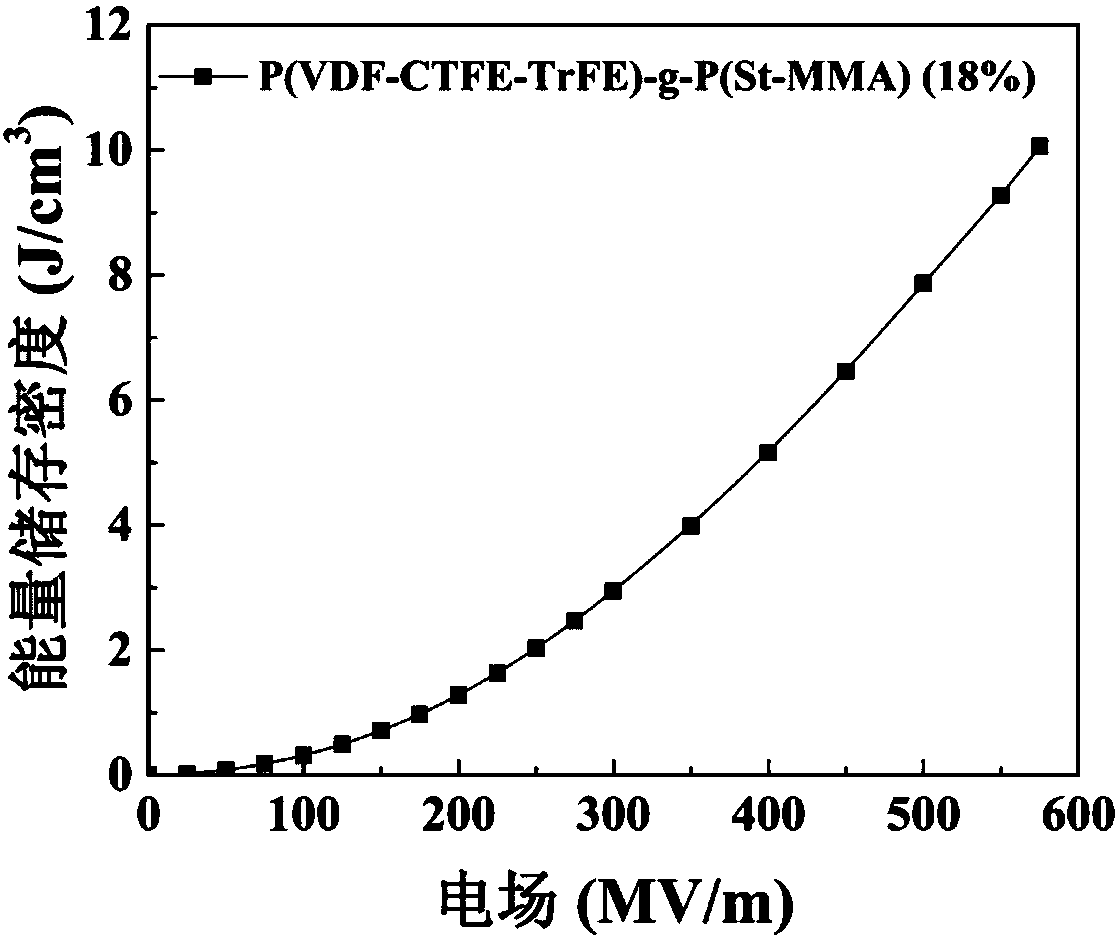Preparation method of anti-ferroelectric poly(vinylidene fluoride-trifluoroethylene-chlorotrifluoroethylene) grafted polymer
A technique for grafting polymers and chlorotrifluoroethylene, which is applied in the field of preparation of fluorine-containing graft polymers, can solve problems such as the reduction of energy storage density of polymers, and achieve low usage content, simple and easy-to-control operations, and easy grafting Effect of Polymer Purification
- Summary
- Abstract
- Description
- Claims
- Application Information
AI Technical Summary
Problems solved by technology
Method used
Image
Examples
Embodiment 1
[0027] This embodiment includes the following steps:
[0028] Step 1. Add the polymer raw material into the three-necked bottle, and add the catalyst, ligand and reducing agent at the same time. After mixing, vacuumize and fill nitrogen for three cycles, add the deoxygenated solvent with a syringe. The mass ratio of the solvent to the polymer raw material 15:1~30:1, stir well, after the polymer raw material is completely dissolved, move the reaction bottle into the oil bath, heat up to 100°C; add the grafted monomer MMA with a syringe, the grafted monomer and the polymer raw material The mass ratio of the graft monomer to the polymer raw material is 1:1 to 5:1, and the temperature is raised to 120°C after 15 minutes of polymerization; the graft monomer St is added with a syringe, and the mass ratio of the graft monomer to the polymer raw material is 1:1 to 10:1 , the polymerization stopped after 30 minutes;
[0029] Step 2. Add acetone to the reaction solution obtained in ste...
Embodiment 2
[0043] This embodiment includes the following steps:
[0044]Step 1. Add the polymer raw material into the three-necked bottle, and add the catalyst, ligand and reducing agent at the same time. After mixing, vacuumize and fill nitrogen for three cycles, add the deoxygenated solvent with a syringe. The mass ratio of the solvent to the polymer is 15:1~30:1, stir well, after the polymer raw material is completely dissolved, move the reaction bottle into the oil bath, heat up to 100°C; add the graft monomer MMA with a syringe, The mass ratio is 1:1 to 5:1, and the temperature is raised to 120°C after 30 minutes of polymerization; the grafted monomer St is added with a syringe, and the mass ratio of the grafted monomer to the polymer raw material is 1:1 to 10:1. Polymerization stopped after 1 hour;
[0045] Step 2. Add acetone to the reaction solution obtained in step 1 to dilute to obtain a diluted reaction solution. The volume ratio of acetone to the reaction solution is 1:3; th...
Embodiment 3
[0059] This embodiment includes the following steps:
[0060] Step 1. Add the polymer raw material into the three-necked bottle, and add the catalyst, ligand and reducing agent at the same time. After mixing, vacuumize and fill nitrogen for three cycles, add the deoxygenated solvent with a syringe. The mass ratio of the solvent to the polymer raw material 15:1~30:1, fully stirred, after the polymer is completely dissolved, move the reaction bottle into the oil bath, and raise the temperature to 100°C; add the grafted monomer MMA with a syringe, the mixture of the grafted monomer and the polymer raw material The mass ratio is 1:1 to 5:1, and the temperature is raised to 120°C after the polymerization reaction for 1 hour; the grafted monomer St is added with a syringe, and the mass ratio of the grafted monomer to the polymer raw material is 1:1 to 10:1, Polymerization stopped after 1.5 hours;
[0061] Step 2. Add acetone to the reaction solution obtained in step 1 to dilute to ...
PUM
 Login to View More
Login to View More Abstract
Description
Claims
Application Information
 Login to View More
Login to View More - R&D
- Intellectual Property
- Life Sciences
- Materials
- Tech Scout
- Unparalleled Data Quality
- Higher Quality Content
- 60% Fewer Hallucinations
Browse by: Latest US Patents, China's latest patents, Technical Efficacy Thesaurus, Application Domain, Technology Topic, Popular Technical Reports.
© 2025 PatSnap. All rights reserved.Legal|Privacy policy|Modern Slavery Act Transparency Statement|Sitemap|About US| Contact US: help@patsnap.com



